2019 TOYOTA SUPRA run flat
[x] Cancel search: run flatPage 273 of 456
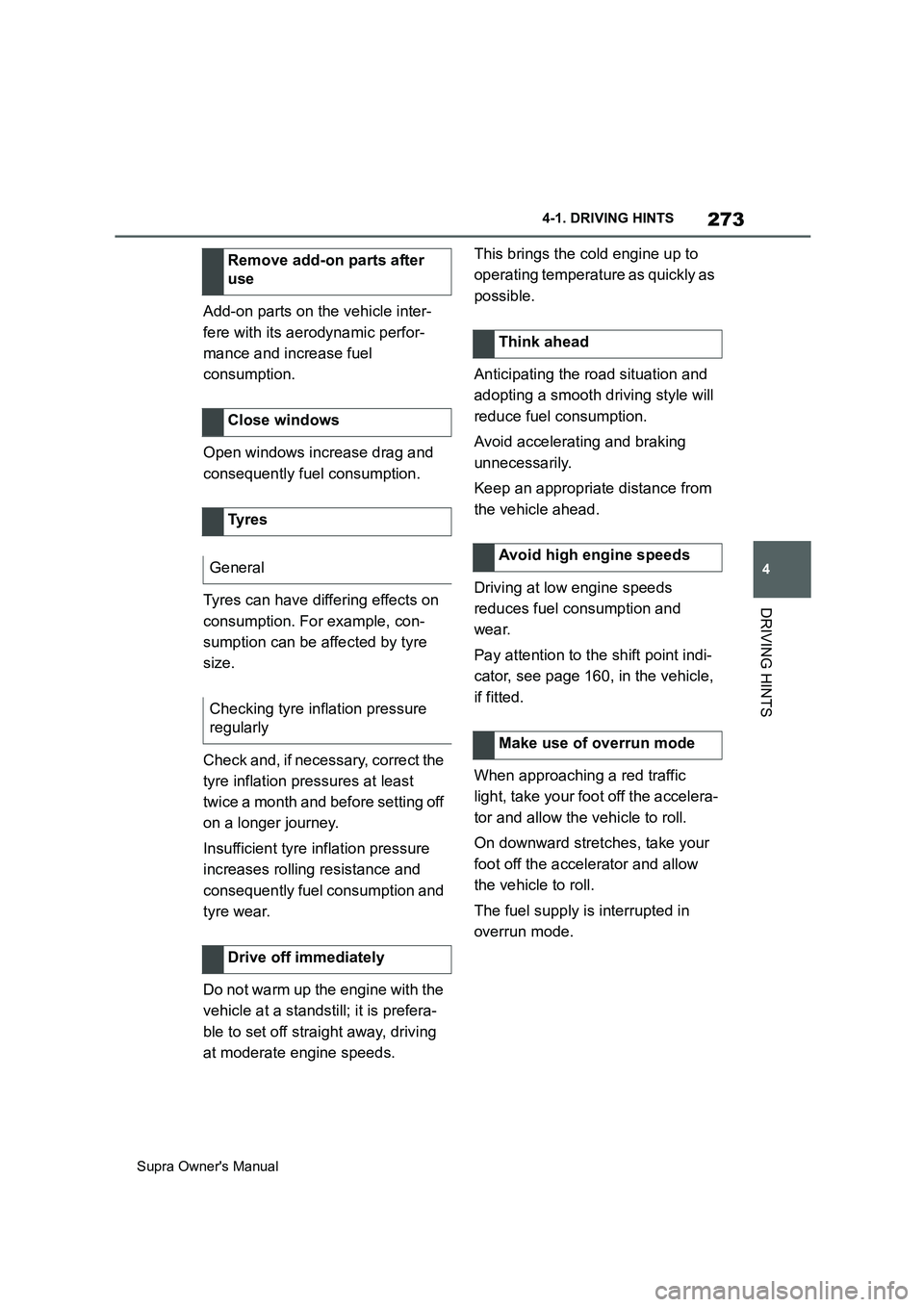
273
4
Supra Owner's Manual4-1. DRIVING HINTS
DRIVING HINTS
Add-on parts on the vehicle inter-
fere with its aerodynamic perfor-
mance and increase fuel
consumption.
Open windows increase drag and
consequently fuel consumption.
Tyres can have differing effects on
consumption. For example, con-
sumption can be affected by tyre
size.
Check and, if necessary, correct the
tyre inflation pressures at least
twice a month and before setting off
on a longer journey.
Insufficient tyre inflation pressure
increases rolling resistance and
consequently fuel consumption and
tyre wear.
Do not warm up the engine with the
vehicle at a standstill; it is prefera-
ble to set off straight away, driving
at moderate engine speeds.This brings the cold engine up to
operating temperature as quickly as
possible.
Anticipating the road situation and
adopting a smooth driving style will
reduce fuel consumption.
Avoid accelerating and braking
unnecessarily.
Keep an appropriate distance from
the vehicle ahead.
Driving at low engine speeds
reduces fuel consumption and
wear.
Pay attention to the shift point indi-
cator, see page 160, in the vehicle,
if fitted.
When approaching a red traffic
light, take your foot off the accelera-
tor and allow the vehicle to roll.
On downward stretches, take your
foot off the accelerator and allow
the vehicle to roll.
The fuel supply is interrupted in
overrun mode. Remove add-on parts after
use
Close windows
Ty r e s
General
Checking tyre inflation pressure
regularly
Drive off immediately
Think ahead
Avoid high engine speeds
Make use of overrun mode
Page 281 of 456
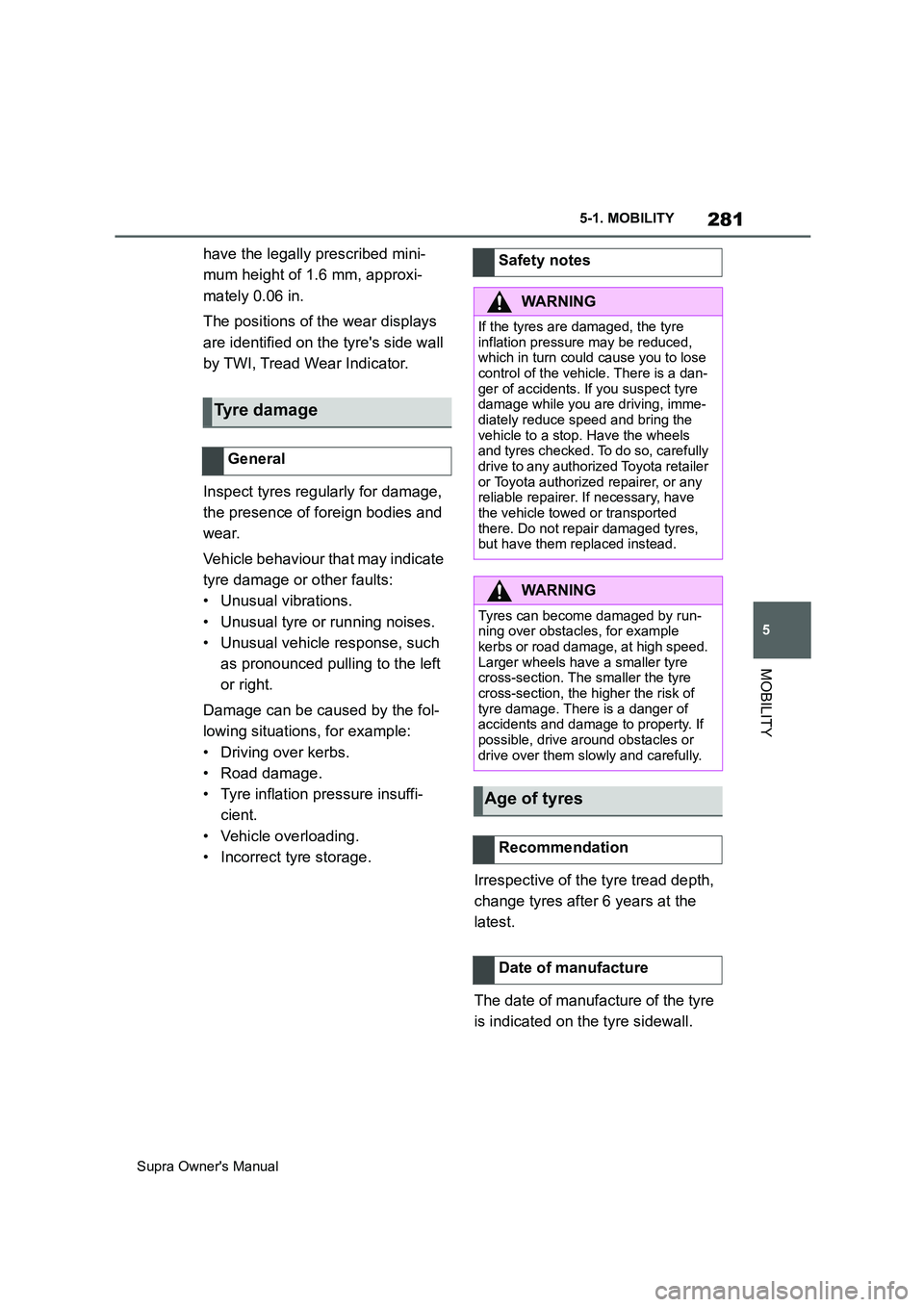
281
5
Supra Owner's Manual5-1. MOBILITY
MOBILITY
have the legally prescribed mini-
mum height of 1.6 mm, approxi-
mately 0.06 in.
The positions of the wear displays
are identified on the tyre's side wall
by TWI, Tread Wear Indicator.
Inspect tyres regularly for damage,
the presence of foreign bodies and
wear.
Vehicle behaviour that may indicate
tyre damage or other faults:
• Unusual vibrations.
• Unusual tyre or running noises.
• Unusual vehicle response, such
as pronounced pulling to the left
or right.
Damage can be caused by the fol-
lowing situations, for example:
• Driving over kerbs.
• Road damage.
• Tyre inflation pressure insuffi-
cient.
• Vehicle overloading.
• Incorrect tyre storage.
Irrespective of the tyre tread depth,
change tyres after 6 years at the
latest.
The date of manufacture of the tyre
is indicated on the tyre sidewall.
Tyre damage
General
Safety notes
WARNING
If the tyres are damaged, the tyre
inflation pressure may be reduced,
which in turn could cause you to lose
control of the vehicle. There is a dan-
ger of accidents. If you suspect tyre
damage while you are driving, imme-
diately reduce speed and bring the
vehicle to a stop. Have the wheels
and tyres checked. To do so, carefully
drive to any authorized Toyota retailer
or Toyota authorized repairer, or any
reliable repairer. If necessary, have
the vehicle towed or transported
there. Do not repair damaged tyres,
but have them replaced instead.
WARNING
Tyres can become damaged by run-
ning over obstacles, for example
kerbs or road damage, at high speed.
Larger wheels have a smaller tyre
cross-section. The smaller the tyre
cross-section, the higher the risk of
tyre damage. There is a danger of
accidents and damage to property. If
possible, drive around obstacles or
drive over them slowly and carefully.
Age of tyres
Recommendation
Date of manufacture
Page 283 of 456
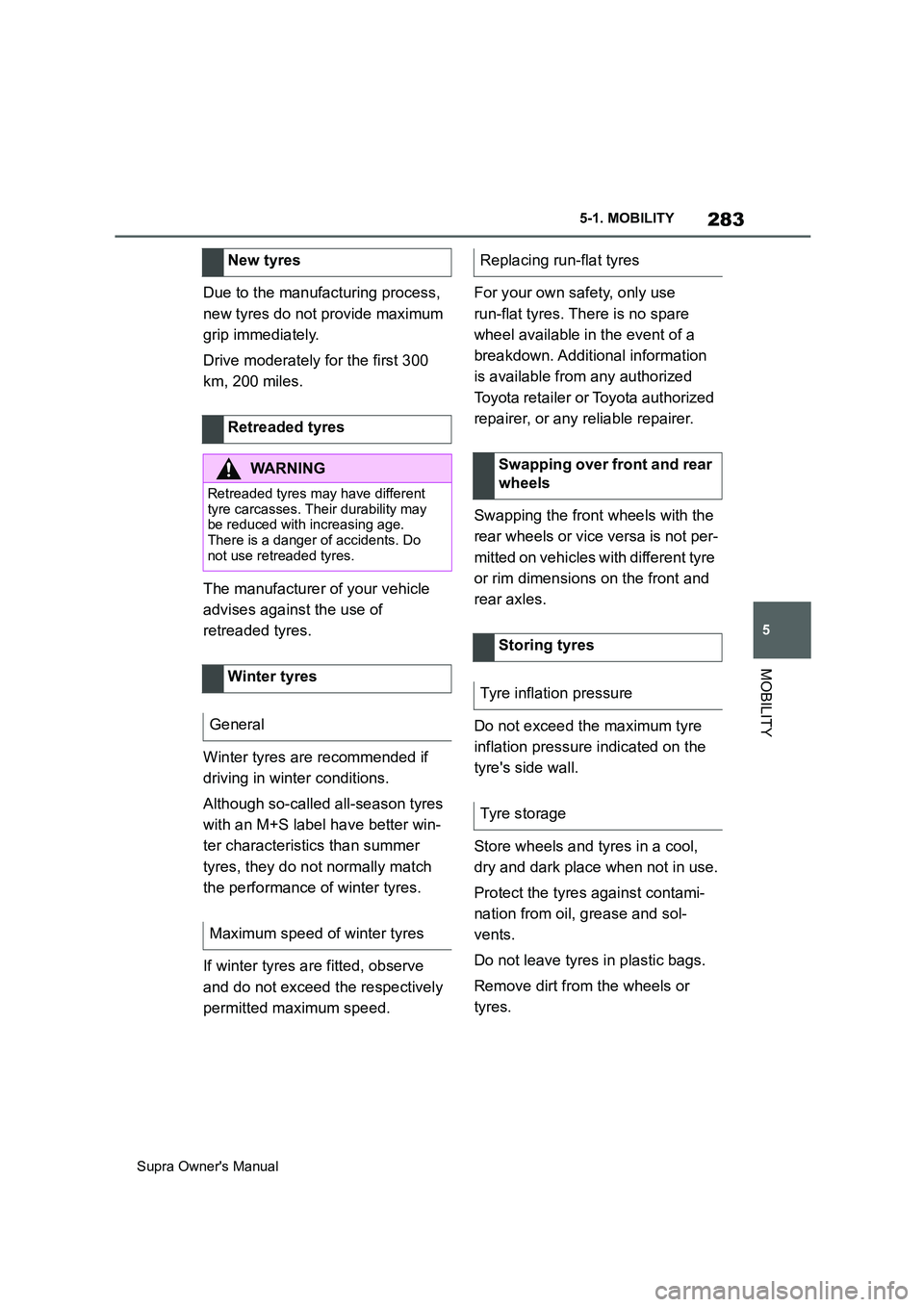
283
5
Supra Owner's Manual5-1. MOBILITY
MOBILITY
Due to the manufacturing process,
new tyres do not provide maximum
grip immediately.
Drive moderately for the first 300
km, 200 miles.
The manufacturer of your vehicle
advises against the use of
retreaded tyres.
Winter tyres are recommended if
driving in winter conditions.
Although so-called all-season tyres
with an M+S label have better win-
ter characteristics than summer
tyres, they do not normally match
the performance of winter tyres.
If winter tyres are fitted, observe
and do not exceed the respectively
permitted maximum speed.For your own safety, only use
run-flat tyres. There is no spare
wheel available in the event of a
breakdown. Additional information
is available from any authorized
Toyota retailer or Toyota authorized
repairer, or any reliable repairer.
Swapping the front wheels with the
rear wheels or vice versa is not per-
mitted on vehicles with different tyre
or rim dimensions on the front and
rear axles.
Do not exceed the maximum tyre
inflation pressure indicated on the
tyre's side wall.
Store wheels and tyres in a cool,
dry and dark place when not in use.
Protect the tyres against contami-
nation from oil, grease and sol-
vents.
Do not leave tyres in plastic bags.
Remove dirt from the wheels or
tyres. New tyres
Retreaded tyres
WARNING
Retreaded tyres may have different
tyre carcasses. Their durability may
be reduced with increasing age.
There is a danger of accidents. Do
not use retreaded tyres.
Winter tyres
General
Maximum speed of winter tyres
Replacing run-flat tyres
Swapping over front and rear
wheels
Storing tyres
Tyre inflation pressure
Tyre storage
Page 284 of 456
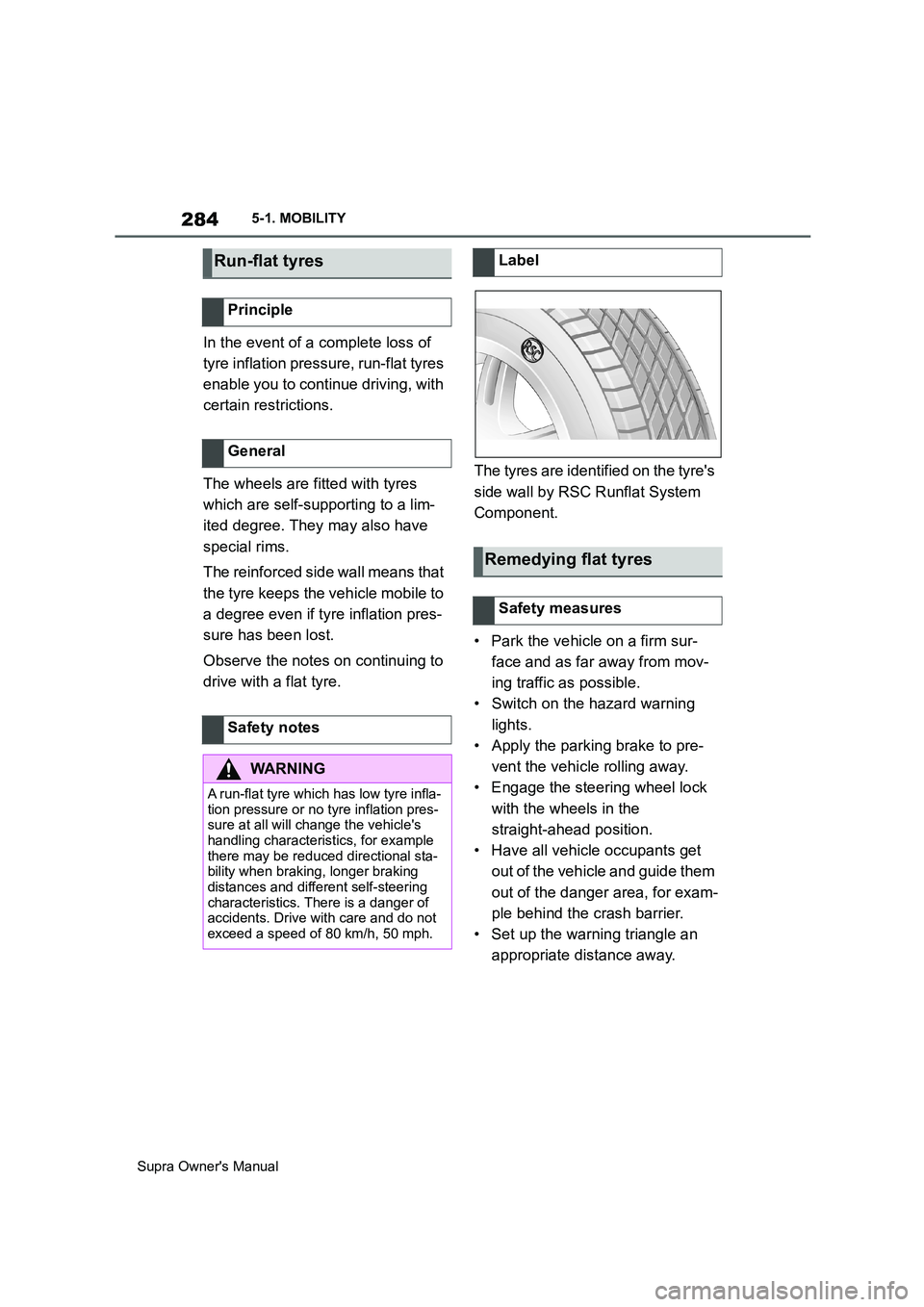
284
Supra Owner's Manual5-1. MOBILITY
In the event of a complete loss of
tyre inflation pressure, run-flat tyres
enable you to continue driving, with
certain restrictions.
The wheels are fitted with tyres
which are self-supporting to a lim-
ited degree. They may also have
special rims.
The reinforced side wall means that
the tyre keeps the vehicle mobile to
a degree even if tyre inflation pres-
sure has been lost.
Observe the notes on continuing to
drive with a flat tyre.The tyres are identified on the tyre's
side wall by RSC Runflat System
Component.
• Park the vehicle on a firm sur-
face and as far away from mov-
ing traffic as possible.
• Switch on the hazard warning
lights.
• Apply the parking brake to pre-
vent the vehicle rolling away.
• Engage the steering wheel lock
with the wheels in the
straight-ahead position.
• Have all vehicle occupants get
out of the vehicle and guide them
out of the danger area, for exam-
ple behind the crash barrier.
• Set up the warning triangle an
appropriate distance away.
Run-flat tyres
Principle
General
Safety notes
WARNING
A run-flat tyre which has low tyre infla-
tion pressure or no tyre inflation pres-
sure at all will change the vehicle's
handling characteristics, for example
there may be reduced directional sta-
bility when braking, longer braking
distances and different self-steering
characteristics. There is a danger of
accidents. Drive with care and do not
exceed a speed of 80 km/h, 50 mph.
Label
Remedying flat tyres
Safety measures
Page 286 of 456
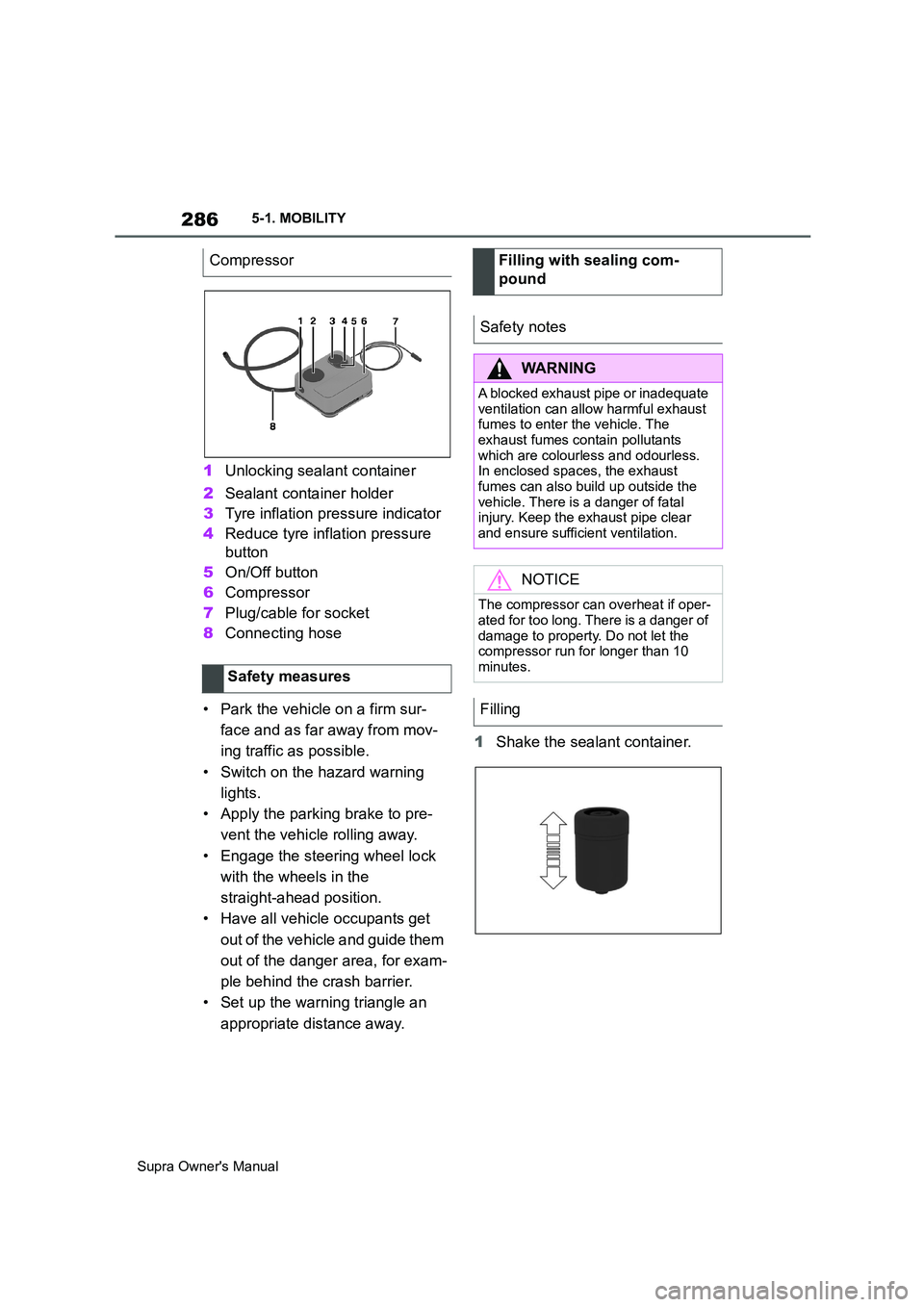
286
Supra Owner's Manual5-1. MOBILITY
1Unlocking sealant container
2Sealant container holder
3Tyre inflation pressure indicator
4Reduce tyre inflation pressure
button
5On/Off button
6Compressor
7Plug/cable for socket
8Connecting hose
• Park the vehicle on a firm sur-
face and as far away from mov-
ing traffic as possible.
• Switch on the hazard warning
lights.
• Apply the parking brake to pre-
vent the vehicle rolling away.
• Engage the steering wheel lock
with the wheels in the
straight-ahead position.
• Have all vehicle occupants get
out of the vehicle and guide them
out of the danger area, for exam-
ple behind the crash barrier.
• Set up the warning triangle an
appropriate distance away.1Shake the sealant container. Compressor
Safety measures
Filling with sealing com-
pound
Safety notes
WARNING
A blocked exhaust pipe or inadequate
ventilation can allow harmful exhaust
fumes to enter the vehicle. The
exhaust fumes contain pollutants
which are colourless and odourless.
In enclosed spaces, the exhaust
fumes can also build up outside the
vehicle. There is a danger of fatal
injury. Keep the exhaust pipe clear
and ensure sufficient ventilation.
NOTICE
The compressor can overheat if oper-
ated for too long. There is a danger of
damage to property. Do not let the
compressor run for longer than 10
minutes.
Filling
Page 287 of 456
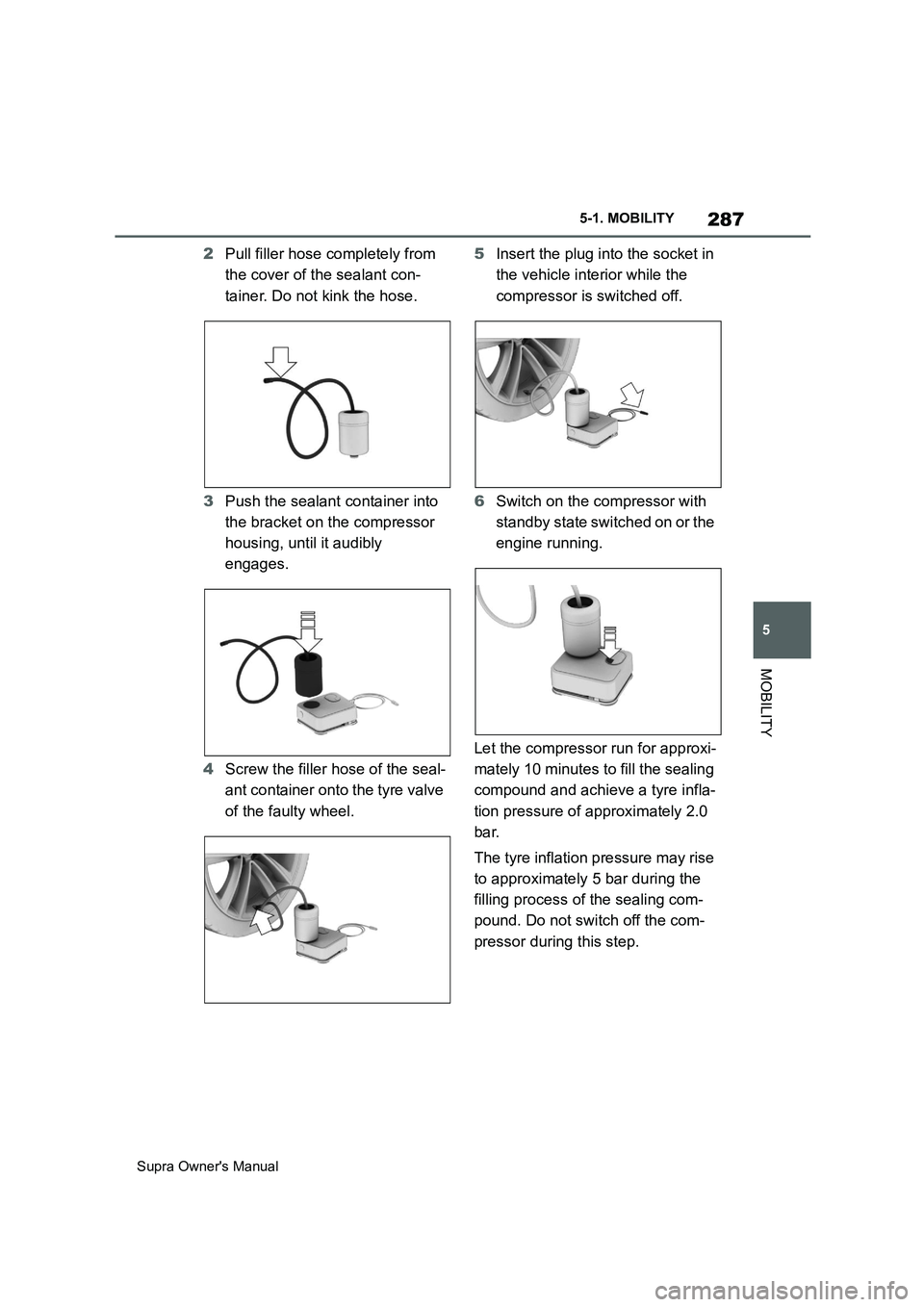
287
5
Supra Owner's Manual5-1. MOBILITY
MOBILITY
2Pull filler hose completely from
the cover of the sealant con-
tainer. Do not kink the hose.
3Push the sealant container into
the bracket on the compressor
housing, until it audibly
engages.
4Screw the filler hose of the seal-
ant container onto the tyre valve
of the faulty wheel.5Insert the plug into the socket in
the vehicle interior while the
compressor is switched off.
6Switch on the compressor with
standby state switched on or the
engine running.
Let the compressor run for approxi-
mately 10 minutes to fill the sealing
compound and achieve a tyre infla-
tion pressure of approximately 2.0
bar.
The tyre inflation pressure may rise
to approximately 5 bar during the
filling process of the sealing com-
pound. Do not switch off the com-
pressor during this step.
Page 288 of 456
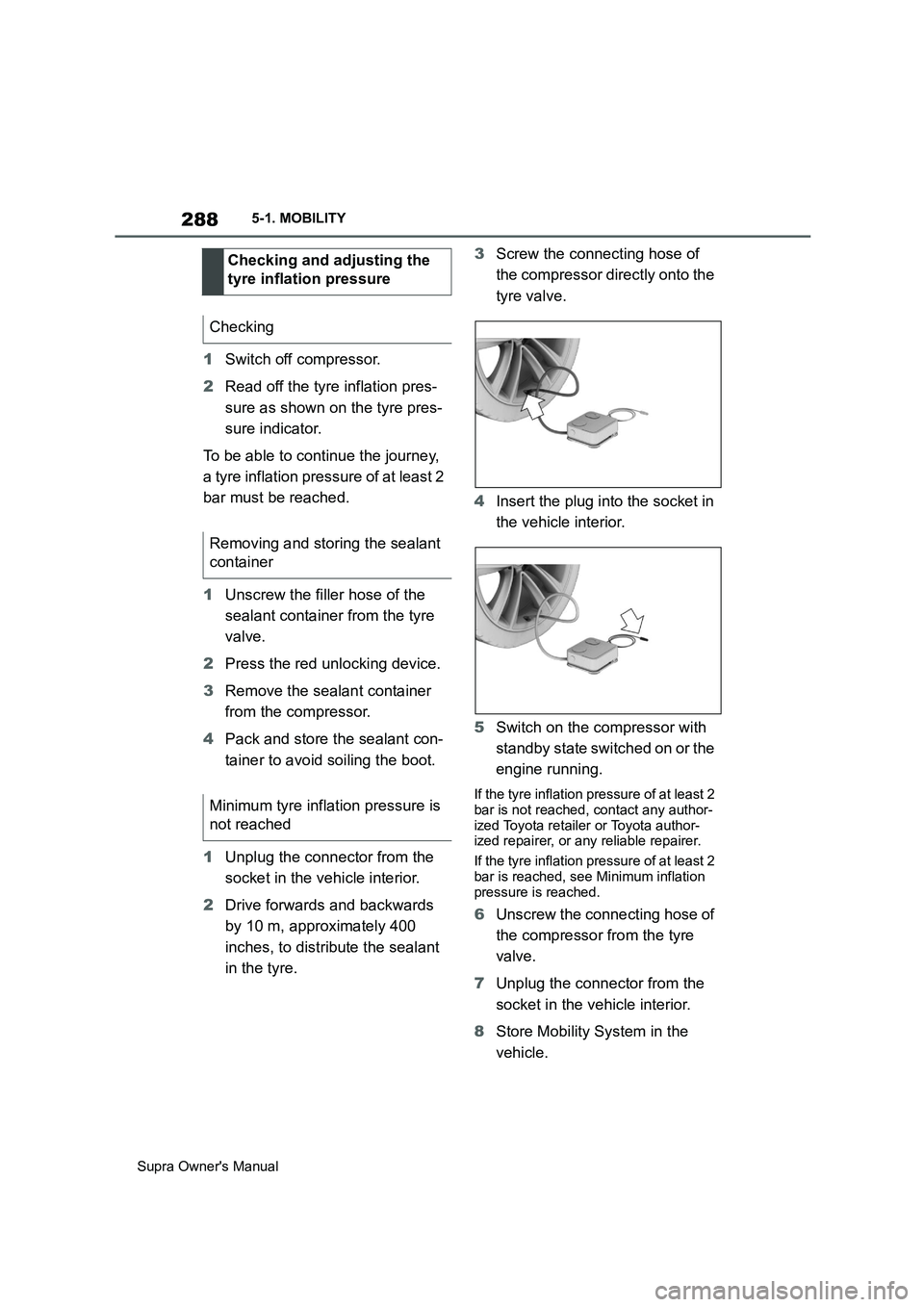
288
Supra Owner's Manual5-1. MOBILITY
1Switch off compressor.
2Read off the tyre inflation pres-
sure as shown on the tyre pres-
sure indicator.
To be able to continue the journey,
a tyre inflation pressure of at least 2
bar must be reached.
1Unscrew the filler hose of the
sealant container from the tyre
valve.
2Press the red unlocking device.
3Remove the sealant container
from the compressor.
4Pack and store the sealant con-
tainer to avoid soiling the boot.
1Unplug the connector from the
socket in the vehicle interior.
2Drive forwards and backwards
by 10 m, approximately 400
inches, to distribute the sealant
in the tyre.3Screw the connecting hose of
the compressor directly onto the
tyre valve.
4Insert the plug into the socket in
the vehicle interior.
5Switch on the compressor with
standby state switched on or the
engine running.
If the tyre inflation pressure of at least 2
bar is not reached, contact any author-
ized Toyota retailer or Toyota author-
ized repairer, or any reliable repairer.
If the tyre inflation pressure of at least 2
bar is reached, see Minimum inflation
pressure is reached.
6Unscrew the connecting hose of
the compressor from the tyre
valve.
7Unplug the connector from the
socket in the vehicle interior.
8Store Mobility System in the
vehicle. Checking and adjusting the
tyre inflation pressure
Checking
Removing and storing the sealant
container
Minimum tyre inflation pressure is
not reached
Page 289 of 456
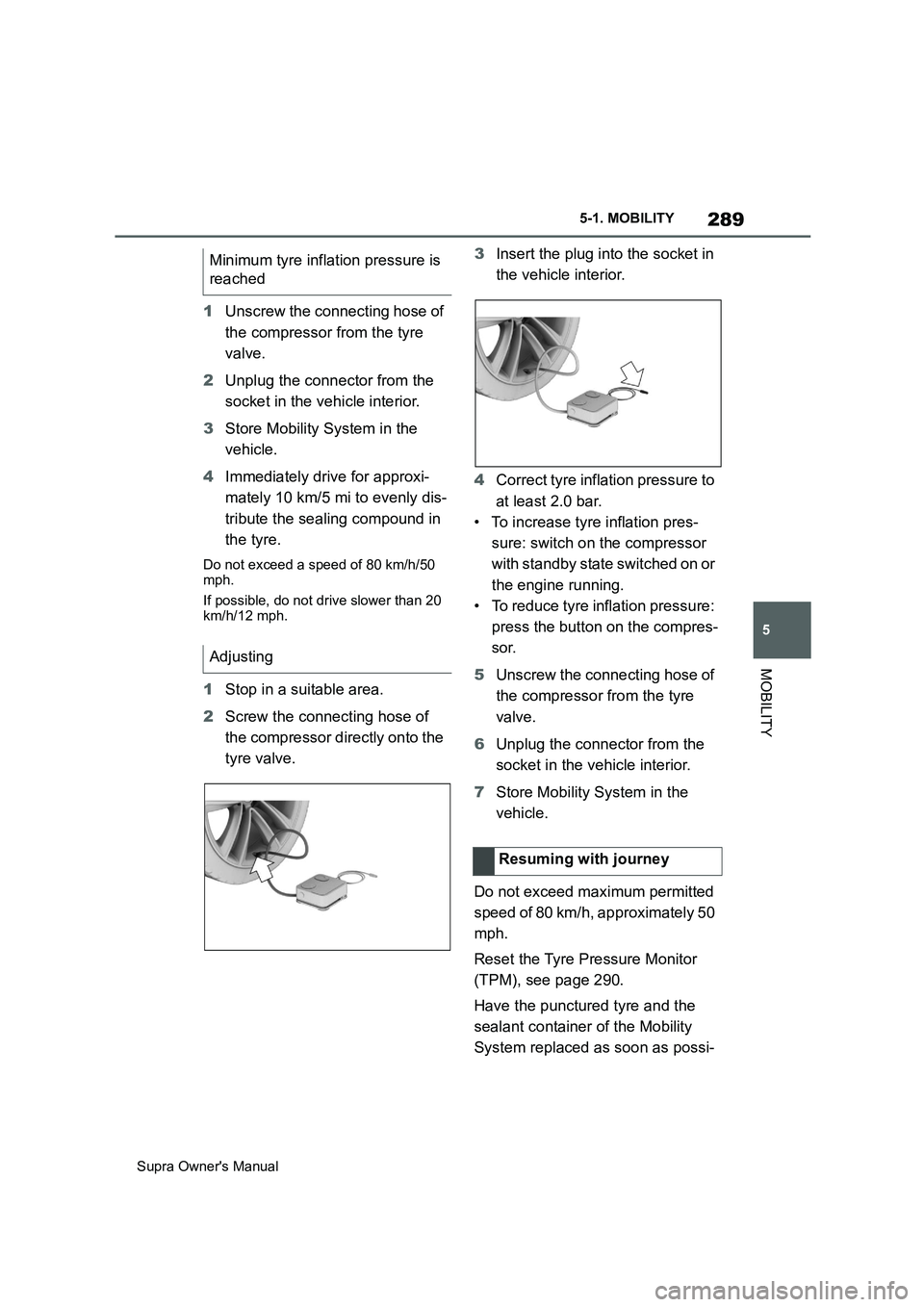
289
5
Supra Owner's Manual5-1. MOBILITY
MOBILITY
1Unscrew the connecting hose of
the compressor from the tyre
valve.
2Unplug the connector from the
socket in the vehicle interior.
3Store Mobility System in the
vehicle.
4Immediately drive for approxi-
mately 10 km/5 mi to evenly dis-
tribute the sealing compound in
the tyre.
Do not exceed a speed of 80 km/h/50
mph.
If possible, do not drive slower than 20
km/h/12 mph.
1Stop in a suitable area.
2Screw the connecting hose of
the compressor directly onto the
tyre valve.3Insert the plug into the socket in
the vehicle interior.
4Correct tyre inflation pressure to
at least 2.0 bar.
• To increase tyre inflation pres-
sure: switch on the compressor
with standby state switched on or
the engine running.
• To reduce tyre inflation pressure:
press the button on the compres-
sor.
5Unscrew the connecting hose of
the compressor from the tyre
valve.
6Unplug the connector from the
socket in the vehicle interior.
7Store Mobility System in the
vehicle.
Do not exceed maximum permitted
speed of 80 km/h, approximately 50
mph.
Reset the Tyre Pressure Monitor
(TPM), see page 290.
Have the punctured tyre and the
sealant container of the Mobility
System replaced as soon as possi- Minimum tyre inflation pressure is
reached
Adjusting
Resuming with journey